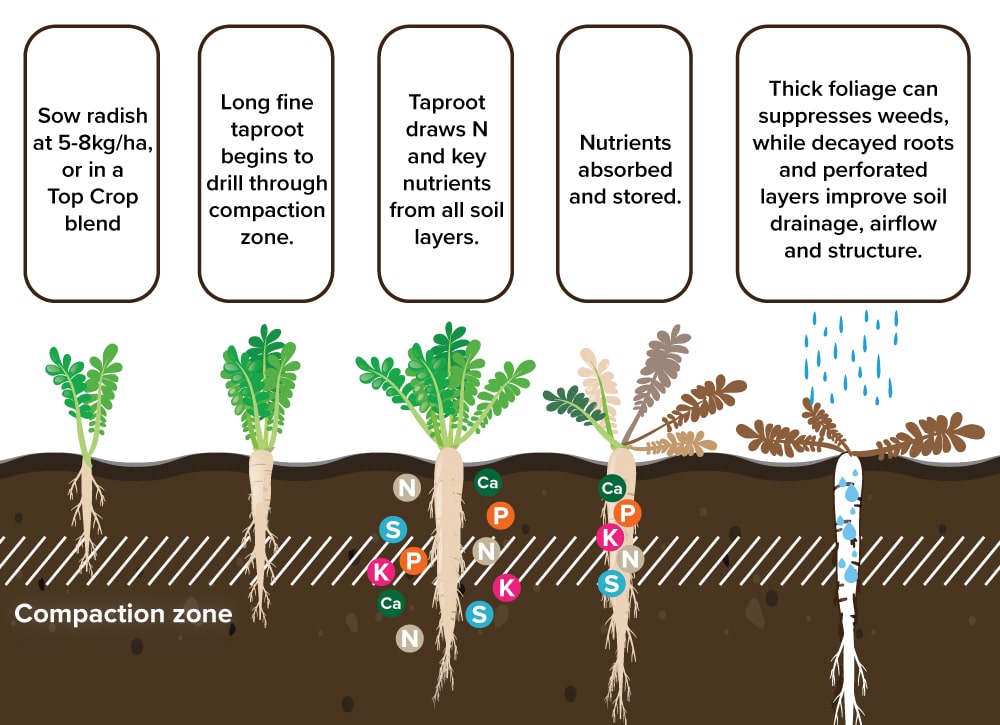When building a summer multi-species mix, every species should have a clear purpose. Some drive bulk feed, others fix nitrogen or provide fast regrowth — and a few are there purely for their functional service to the soil. Forage Radish sits firmly in that last category.
Built for Soil
While many summer brassicas are selected for leaf yield or animal performance, Forage Radish brings value outside of this. Its strength lies below the surface — in what its roots do for the paddock.
The signature taproot can drill through compacted layers, creating natural “drainage lines” that later become infiltration and aeration channels for following crops or pastures. As the root decomposes, it releases nutrients.
A Biological Engineer in the Blend
In our Notman Pasture Seed Top Crop and Summer Multi-Species blends, Forage Radish plays the quiet but important role.
It’s not there to be grazed — it’s there to support its companion species.
- Millet and sorghum bring fibrous rooting and feed.
- Leafy brassicas and herbs add diversity above ground.
- Legumes like red clover, cowpea or lablab fix atmospheric nitrogen (under summer irrigation generally)
- Forage Radish, meanwhile, can anchors the system — reaching down, breaking through, and recycling nutrients for future use.
Together, these layers form a living network that can improve soil tilth and create a diverse summer blend that generally out performs pasture as it declines in quality and quantity post Christmas.
How It Works
- Taproot effect: drills deep, relieving compaction naturally.
- Nutrient scavenger: captures mobile nutrients (N, S, K) that might otherwise leach.
- Rapid cover: suppresses weeds while protecting the soil surface.
- Decomposition: decays quickly, leaving pores and fertility for autumn sowing.
Because it’s short-lived — usually 60–80 days — it completes its function early, allowing other species to continue the summer program without competition.
Simple to Add, Big Impact
A little goes a long way. In mixed summer blends, Forage Radish is typically sown at 1–1.5 kg/ha, paired with warm-season grasses, legumes, or leafy brassicas.
It’s easy to handle in the mix, germinates fast in warm soil, and fits neatly into post-silage and early-summer sowing windows.
Our Top Crop Approach
At Notman Pasture Seeds, we design summer blends with clear functional layers — each species serving a defined purpose within the system. Forage Radish might not fill a feed trough, but it fills a crucial role underground, setting up better pasture, better infiltration, and better resilience across the rotation.
| Category | Details |
|---|---|
| Primary Function | Soil structure improvement, nutrient recycling, weed suppression |
| Role in Blend | Functional layer – not for feed; supports soil and following crops |
| Ideal Mix Partners | Millet, Sorghum, Forage Rape, Leafy Turnip, Chicory |
| Sowing Rate (in mix) | 1–1.5 kg/ha |
| Sowing Depth | 10–15 mm into moist, well-prepared seedbed |
| Optimum Sowing Time | Mid spring to early summer |
| Growth Duration | 60–80 days to maturity (short-term summer species) |
| Grazing / Feed Value | Minimal – used primarily for soil function, not forage |
| Soil Benefits | Breaks compaction, enhances infiltration, captures N/S/K, improves tilth |
| Rotation Fit | Ideal before autumn pasture or crop establishment |
| Moisture Needs | Performs best under moderate summer moisture – avoid extreme dry |
| Residue Management | Naturally decomposes; no cultivation required before next sowing |







